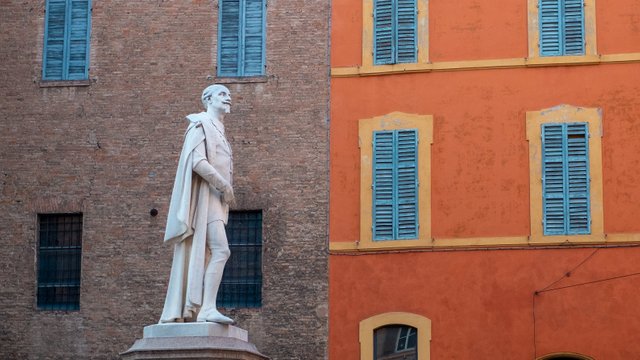Statue of Alessandro Tassoni, Italian poet and writer

Tassoni Alessandro. - Writer (Modena 1565 - ibid. 1635). His figure as an author established himself in Italian literature above all with the composition of La secchia rapita (1621), a heroicomic poem with which T. attempted to give Italy a new genre, a mix of comic and serious.
His most famous work is certainly La secchia rapita, a poem in octaves in 12 songs (publ. 1621, dated 1622, with the title La secchia; ed. Magazines, with the definitive title, 1624 and 1630). It starts from a humble fact historically happened: in the battle of Zappolino in 1325 the Modenese, chasing the Bolognese up to the S. Felice gate, took away a bucket as a trophy. T. did not stick to history and chronology, but made it a casual hodgepodge, introducing contemporary characters and facts into the work, transvestites. Topic is the war between Bolognesi and Modenesi following the refusal of the latter to return precisely the kidnapped bucket; the gods of Olympus participate in the war on both sides. Although T.'s intentions were to create a new literary genre in which the comic parts were mixed with the serious ones, in reality the latter are worth very little; tasty, however, almost always the comic and sarcastic ones (the same attitudes to satire and comedian appear in one of his sonnets); and ultimately the poem only continues the satirical-burlesque tradition that by the fourteenth century, through Pulci, had found in Berni and Folengo the most singular expressions, even in the scheme of the heroic poem. But with this poem chivalry as an institution and as an ideal is definitively dissolved in mockery, without regrets, and consequently it gives the coup de grace to the chivalric poem.
Other works of T. are the Ten books of different thoughts (ed. Defin. 1620), a characteristic mixture of new and retroactive ideas, of acuteness of ingenuity and of bizarre or irreverence or lightness, of which the 10th has particular interest, because the famous question about the superiority of the ancients or the moderns is already outlined; the Considerations on the Rime del Petrarca, of which he left four editorial offices (two publ. in 1609 and 1611), original work, full of witticisms, digressions, comparisons, in which Petrarchists and marinists are affected, but Petrarch himself is not spared hence a lively controversy with Giuseppe degli Aromatari; the first song of a youth poem on the discovery of America, the Ocean; lively and interesting letters. He is also credited with two Filippiche (1614-15), vehement political orations on the sad conditions of Italy, in which the Italian princes are urged to help Carlo Emanuele I of Savoy to free Italy from Spanish domination, and the sarcastic response ( 1617) to the speech of a Genoese Soccino, who had claimed that the dominion of the Spaniards in Italy was right.
!sc ban
Refusal to stop plagiarism.
They are already banned.